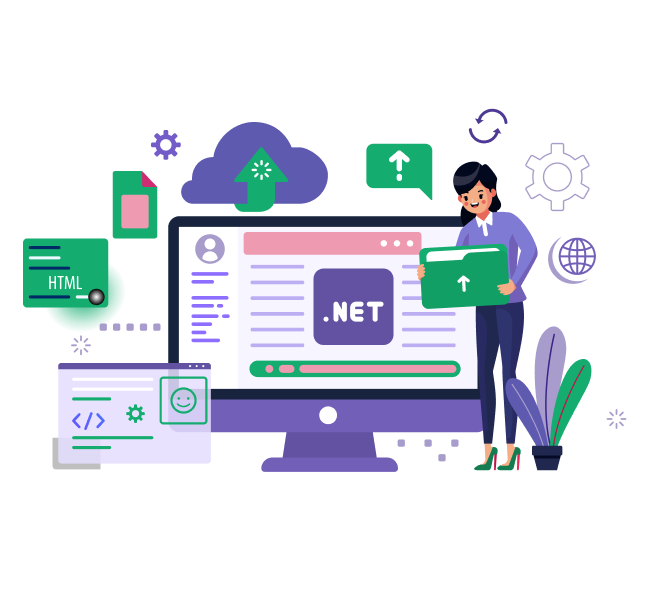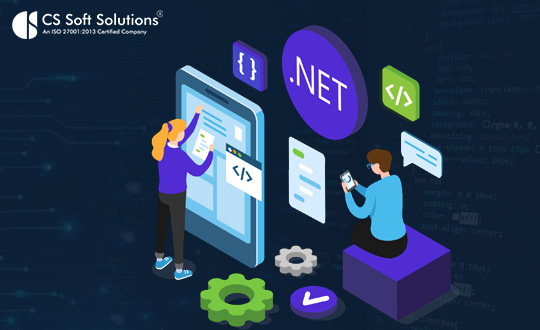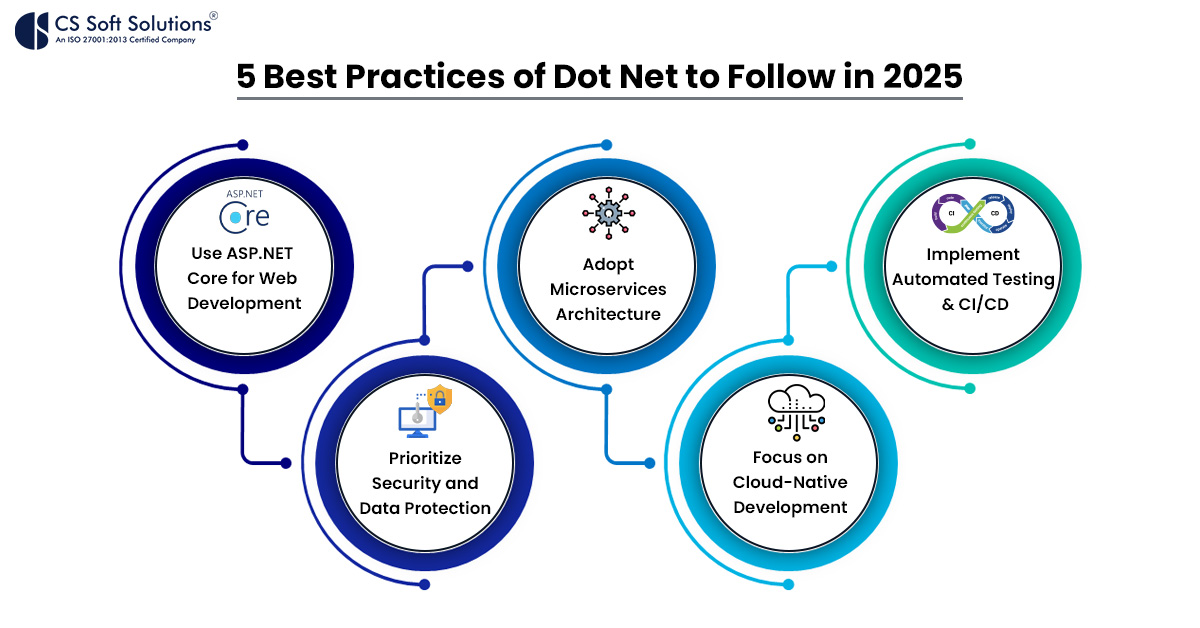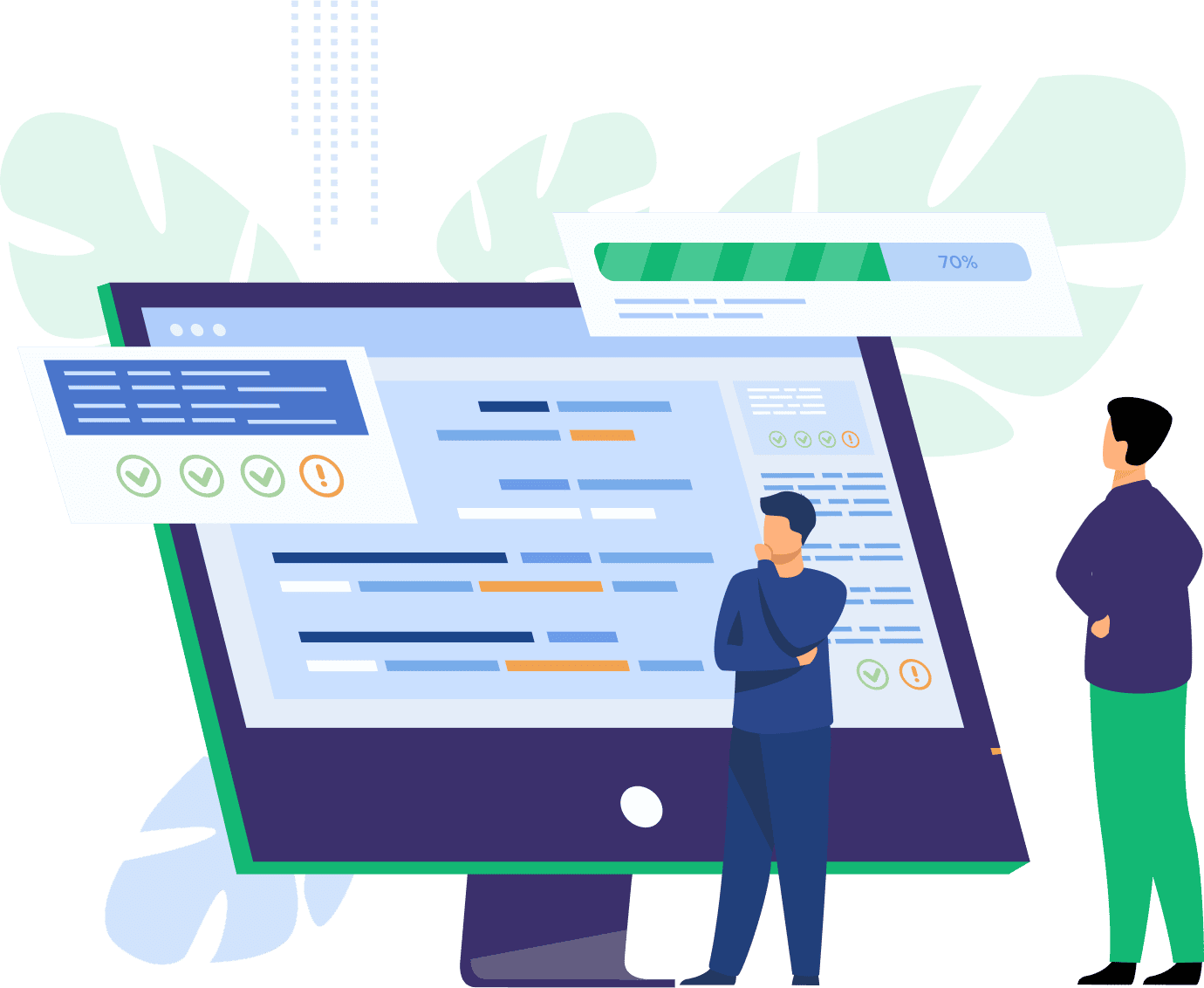In the continually evolving world of technology, it is becoming mandatory to adopt the latest best practices and trends to enhance software development. In 2025, there will be many new opportunities and challenges expected for those providing .NET development services. You can’t even imagine success without having advanced knowledge and proven practices that improve the performance, scalability, security, and maintenance of .NET projects.
In this blog, you will find the best .NET development practices that every full-stack developer and dot net development service provider to follow in the upcoming year 2025.
Summary of .NET Development Best Practices for 2025
| Best Practice | Key Actions | Benefits |
| 1. Use ASP.NET Core for Web Development | – Utilize Minimal APIs
– Leverage Blazor for Client-Side – Optimize with Asynchronous Code |
Simplifies development, improves performance, and enhances interactivity with reduced JavaScript dependency. |
| 2. Prioritize Security and Data Protection | – Strong Authentication & Authorization
– Enforce HTTPS – Regular Security Updates |
Protects against cyber threats, ensures data safety, and maintains compliance with regulations. |
| 3. Adopt Microservices Architecture | – Decouple Application Components
– Use Containers and Kubernetes – Efficient Communication
|
Enhances scalability, maintainability, and flexibility; reduces risk of system-wide failures. |
| 4. Focus on Cloud-Native Development | – Leverage Azure Services
– Implement Serverless Architectures – Use Managed Services
|
Provides scalability, flexibility, and cost-efficiency; simplifies operations with cloud-native solutions. |
| 5. Implement Automated Testing & CI/CD | – Test-Driven Development (TDD)
– Unit, Integration, End-to-End Testing – CI/CD Pipelines
|
Ensures high-quality code, reduces bugs, and accelerates deployment cycles with continuous integration. |
1. Get the Power of ASP.NET Core for Modern Web Development
ASP.NET Core is the main framework for modern web development due to its high performance, flexibility, and cross-platform capabilities. For the ASP.NET Core developer, it is essential to use the full potential of this framework to come up with scalable and high-performance web applications in 2025. Some key aspects that need to focus on are:
- Utilize Minimal APIs: ASP.NET Core 6 supports minimal APIs that work towards reducing the code while developing APIs. It keeps the application lighter and has some improvement in readability at a faster pace. For the microservices development, there will be regular implementation of Minimal APIs for lightweight and efficient applications.
- Use Blazor for Client-Side Interactivity: There is another key feature of ASP.NET Core Blazor is that it enables developers to build an interactive web application in C# with no use of JavaScript. This is a huge advantage for those teams that already have proficiency and experience within the .NET ecosystem. As a full-stack developer in the year 2025, use the Blazor in constructing highly interactive and responsive applications with less dependency on JavaScript libraries and frameworks.
- Optimize Performance by Using Asynchronous Programming: This is another very important factor for any web application development, and this can be achieved by using asynchronous programming. Patterns of asynchronous programming with async and await make sure that no operation is blocked; this enhances the application’s responsiveness. Thus, this can be considered one of the important factors in the development of ASP.NET applications targeting high-traffic environments.
2. Priority to Security and Data Protection
Security is the major concern for .NET development services in today’s world when there is a high increase in cyber-attacks and data breaches. The best security practices should be implemented to protect sensitive information from unauthorized access and for regulatory compliance.
- Strong Authentication and Authorization: This should be implemented using ASP.NET Core Identity and third-party services such as Azure Active Directory. Also, role-based and policy-based authorization can be implemented to further restrict access to various parts of your application.
- Use of HTTPS and Data Encryption HTTPS: It should be used to encrypt transmitted data between the client and the server. The sensitive data stored in the databases and configuration files should be encrypted using data encryption techniques. ASP.NET Core has built-in support for encrypting sensitive information, which can be integrated into your project quickly.
- Keep Up to Date with Security Patches and Best Practices: Keep updating your .NET framework and libraries to hold the recent security patches. Also, keep updated with emerging security threats and follow best practices like input validation, output encoding, and dependency management to reduce potential risks.
3. Utilize Microservices Architecture to achieve scalability and flexibility:
In 2025, the Microservices architecture trend is expected to keep on shining because it is highly scalable and can handle application development without being rigid. For the service providers of .NET development services, the adaptation of microservices can assist them in many ways:
- Decoupling Services for Better Maintainability: It allows different components of an application to be decoupled. This makes its development, testing, and deployment far easier than other services. It helps in maintainability on a module basis rather than crashing the entire system.
- Enable Deployment with Containers and Kubernetes: The deployment of microservices-based applications in today’s world is crucial with the use of containers, such as Docker, and their arrangement with tools like Kubernetes. Containerizing .NET applications ensures full stack developers maintain consistency across the development, testing, and production environments, while Kubernetes offers advanced capabilities to scale and manage such applications.
- Implement Effective Communication Strategies: In the microservice architecture, communication between services becomes an important part of development. The ASP.NET Core developer should utilize very lightweight communication protocols such as gRPC or HTTP/2 that reduce latency and make effective data exchange between services.
4. Focus on Cloud-Native Development with .NET
The need for moving to the cloud means that any .NET development service in 2025 will have to be cloud native. Cloud-native applications are built for better scalability, flexibility, and cost efficiency.
- Better Integration with Azure and Cloud Services: Microsoft Azure supports a wide range of cloud services that are seamlessly integrated into .NET applications. Using Azure App Services, Azure Functions, and Azure SQL Database, developers can develop highly scalable and reliable cloud applications. Full-stack developers may want to take advantage of Azure DevOps for continuous integration and deployment or CI/CD.
- Enforcing Serverless Architecture: Serverless computing allows developers to write code with no pain in managing the infrastructure. In .NET, Azure Functions is an excellent platform for developing serverless applications that scale themselves automatically based on demand. The serverless architecture is appropriate for applications with variable loads, as it saves money by paying only for what consumption an application requires and increases efficiency.
- Managed Services for Simplified Operations: Developers can avail themselves quickly of ready-to-use solutions to common application needs through managed services such as Azure Logic Apps, Azure Service Bus, and Azure Cosmos DB. This kind of service will reduce development time and effort while giving scalable and reliable options for the storage of data, messaging, and automation of workflows.
5. Implement Automated Testing and Continuous Integration for Quality Assurance
In 2025, high quality and reliability in the development of .NET applications will become even more critical. Automated testing and CI are core practices that form a building block to help your applications be robust and accurate.
- Perform Test-Driven Development (TDD): The approach of TDD means that the tests are written even before the code, ensuring that the codebase has been tested for bugs, and later on, has no bugs with any new features or any kind of changes being made. Experienced .NET developers should have already upgraded to TDD so that their code is maintainable and of better quality.
- Utilize Unit Testing, Integration Testing, and End-to-End Testing: Different ranges of testing come on different levels. Unit testing is about making sure each piece works, whereas integration testing covers whether the pieces work with each other, and end-to-end testing takes everything into view from the point of view of a user.
- CI/CD Pipelines: With the implementation of the CI/CD pipelines, the build, test, and deployment are automated for faster delivery at high quality. Applying appropriate tools such as Azure DevOps, Jenkins, and GitHub Actions will further accelerate these processes, hence making time to market quicker with reduced chances of errors during deployment.
Conclusion
New best practices and technologies are continuously appearing in .NET development. Therefore, for your project to stay ahead, it’s necessary to establish its foundation for further successful improvements. Modernization via ASP.NET Core, security priorities, the adoption of microservices architecture, cloud-native development, and automated testing with CI/CD pipelines-the most mentioned features for surefire success over the next couple of years will make the services reach success in 2025 and further.
CS Soft Solutions India Pvt. Ltd. is also here with a team of professional developers who are continuously adopting these best practices to build scalable, secure, and highly-performing applications to meet the needs of modern businesses and users. They are also incorporating these tips into the cycle to keep ahead in the evolving software development world.











